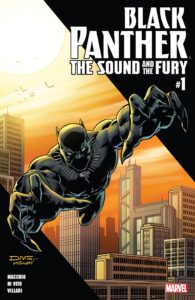 Black Panther: The Sound and the Fury #1 (of 1) — Writer: Ralph Macchio; Art: Andrea di Vito; Colors: Laura Villari
Black Panther: The Sound and the Fury #1 (of 1) — Writer: Ralph Macchio; Art: Andrea di Vito; Colors: Laura Villari
Rise of the Black Panther #2 (of 6) — Writer: Evan Narcisse; Consultant: Ta-Nehisi Coates; Art: Javier Pina; Colors: Stephane Paitreau
X-Men Red #1 — Writer: Tom Taylor; Art: Mahmud Asrar; Colors: Ive Svorcina
X-Men Gold #21 — Writer: Marc Guggenheim; Pencils: Diego Bernard; Inks: JP Mayer; Colors: Arif Prianto
 Rogue and Gambit #2 (of 5) — Writer: Kelly Thompson; Art: Pere Perez; Colors: Frank D’Armata
Rogue and Gambit #2 (of 5) — Writer: Kelly Thompson; Art: Pere Perez; Colors: Frank D’Armata
Infinity Countdown: Adam Warlock #1 (of 1) — Writer: Gerry Duggan; Art: Michael Allred; Colors: Laura Allred
Lots of worthy comics this week, so let’s get started: with the Black Panther movie opening next week (and currently reviewing at a 99% favorable rating on Rotten Tomatoes), Marvel’s naturally got a couple of titles to supplement the regular comic. Black Panther: The Sound and the Fury is a one-shot containing a new 20-page story involving old  nemesis Klaw, who’s placed an impenetrable dome of sound over the city of Dubai, and is asking for $5 billion to remove it. It’s fine but generic; the real attraction is the at-no-extra-cost reprint of Fantastic Four #53 — that’s the second part of the very first Panther story, and while the first part, FF #52, has been reprinted quite a bit, this one is much less familiar. It’s a tribute to both Jack Kirby and Stan Lee (who are at the top of their considerable powers here) that, while it’s over fifty years old, T’Challa comes off as cultured, clever, heroic and smart, with almost none of the mid-20th-century stereotyping that we might expect; if you haven’t read this story, then it’s more than worth the book’s $3.99 cover
nemesis Klaw, who’s placed an impenetrable dome of sound over the city of Dubai, and is asking for $5 billion to remove it. It’s fine but generic; the real attraction is the at-no-extra-cost reprint of Fantastic Four #53 — that’s the second part of the very first Panther story, and while the first part, FF #52, has been reprinted quite a bit, this one is much less familiar. It’s a tribute to both Jack Kirby and Stan Lee (who are at the top of their considerable powers here) that, while it’s over fifty years old, T’Challa comes off as cultured, clever, heroic and smart, with almost none of the mid-20th-century stereotyping that we might expect; if you haven’t read this story, then it’s more than worth the book’s $3.99 cover  price. Rise of the Black Panther is a mini-series about T’Challa’s early days; here, he becomes the Black Panther (but isn’t yet king) and has his first meeting with Namor, the Sub-Mariner, involving one of those standard two-heroes-fight misinterpretations , exacerbated by Namor’s legendary hotheadedness. While regular Panther writer Ta-Nehisi Coates is listed first on the cover, his inside credit says he was a “consultant” here; the actual writing was by Evan Narcisse, and, presumably with Coates’s help, he and artist Javier Pina provide a character that’s more Afrocentric, and closer to the movie version, than The Sound and the Fury. The Black Panther and Namor show up in X-Men Red#1, too — a now-returned Jean Grey has put together a team (Nightcrawler,
price. Rise of the Black Panther is a mini-series about T’Challa’s early days; here, he becomes the Black Panther (but isn’t yet king) and has his first meeting with Namor, the Sub-Mariner, involving one of those standard two-heroes-fight misinterpretations , exacerbated by Namor’s legendary hotheadedness. While regular Panther writer Ta-Nehisi Coates is listed first on the cover, his inside credit says he was a “consultant” here; the actual writing was by Evan Narcisse, and, presumably with Coates’s help, he and artist Javier Pina provide a character that’s more Afrocentric, and closer to the movie version, than The Sound and the Fury. The Black Panther and Namor show up in X-Men Red#1, too — a now-returned Jean Grey has put together a team (Nightcrawler, 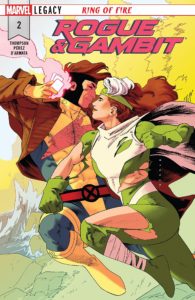 Namor, the Laura Kinney Wolverine and her younger clone sidekick) to rescue young mutants, and goes to the UN to petition for their recognition of a “mutant nation” defined, not by geography, but by geneology. It’s pretty good, thanks to an “Oh, crap” moment and villain reveal near the end, and an effective launch for the newest ongoing X-book. X-Men Gold kicks off a new arc with that Kitty Pryde-led team, down a couple of members, up against a “Brotherhood of Evil Mutants” including Mesmero and new versions of Pyro and Avalanche; Diego Bernard’s got a rare talent for both detailed faces and classic superhero splashes, and is the biggest draw here. Rogue and Gambit plays like a classic TV adventure/romance, as the two squabbling ex-lovers are undercover at a couples therapy
Namor, the Laura Kinney Wolverine and her younger clone sidekick) to rescue young mutants, and goes to the UN to petition for their recognition of a “mutant nation” defined, not by geography, but by geneology. It’s pretty good, thanks to an “Oh, crap” moment and villain reveal near the end, and an effective launch for the newest ongoing X-book. X-Men Gold kicks off a new arc with that Kitty Pryde-led team, down a couple of members, up against a “Brotherhood of Evil Mutants” including Mesmero and new versions of Pyro and Avalanche; Diego Bernard’s got a rare talent for both detailed faces and classic superhero splashes, and is the biggest draw here. Rogue and Gambit plays like a classic TV adventure/romance, as the two squabbling ex-lovers are undercover at a couples therapy  retreat; that gives them a chance to air their grievances and present dueling versions of their first meeting before the inevitable fight and villain reveal. Writer Thompson’s really good at the relationship soap-opera stuff, and clearly shares her audience’s affection for the two star-crossed mutant lovers; it’s smart timing to have this comic out the week before Valentine’s Day. Infinity Countdown: Adam Warlock gets readers up to speed on that character’s’s origin and history, and positions him as the catalyst for Marvel’s Avengers-movie-connected summer event; if that’s not enough, it’s 30 pages of Michael Allred drawing Warlock, Kang, Thanos, Rama Tut and others: what more reason could you possibly need?
retreat; that gives them a chance to air their grievances and present dueling versions of their first meeting before the inevitable fight and villain reveal. Writer Thompson’s really good at the relationship soap-opera stuff, and clearly shares her audience’s affection for the two star-crossed mutant lovers; it’s smart timing to have this comic out the week before Valentine’s Day. Infinity Countdown: Adam Warlock gets readers up to speed on that character’s’s origin and history, and positions him as the catalyst for Marvel’s Avengers-movie-connected summer event; if that’s not enough, it’s 30 pages of Michael Allred drawing Warlock, Kang, Thanos, Rama Tut and others: what more reason could you possibly need?
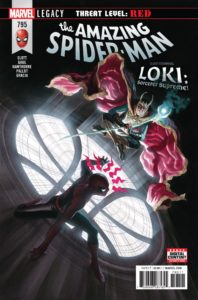 Amazing Spider-Man #795 — Writers: Dan Slott and Christos Gage; Pencils: Mike Hawthorne; Inks: Terry Pallot; Colors: Marte Gracia
Amazing Spider-Man #795 — Writers: Dan Slott and Christos Gage; Pencils: Mike Hawthorne; Inks: Terry Pallot; Colors: Marte Gracia
Spider-Man #237 — Writer: Brian Michael Bendis; Art: Oscar Bazaldua; Colors: Brian Reber
She-Hulk #162 — Writer: Mariko Tamaki; Art: Jahnoy Lindsay; Colors: Federico Blee
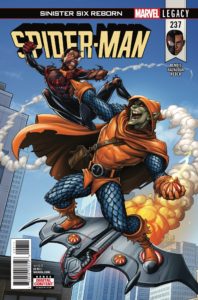 Runaways #6 — Writer: Rainbow Rowell; Art: Kris Anka; Colors: Matthew Wilson
Runaways #6 — Writer: Rainbow Rowell; Art: Kris Anka; Colors: Matthew Wilson
Avengers #679 — Writers: Mark Waid, Al Ewing and Jim Zub; Art: Kim Jacinto; Colors: David Curiel
Black Bolt #10 — Writer: Saladin Ahmed; Art/Colors:  Christian Ward with Stephanie Hans
Christian Ward with Stephanie Hans
Hawkeye #15 — Writer: Kelly Thompson; Art: Leonardo Romero; Colors: Jordie Bellaire
Dan Slott continues to wrap up loose ends as he completes his Amazing Spider-Man run; in #795, now-Sorceror Supreme Loki shows up to return a long-promised favor. The last scene sets up the blowout climax-at-issue-#800″ 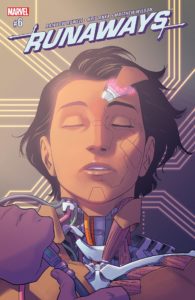 arc, “Red Goblin,” and when you read it you’ll see why it has that title. Spider-Man is nearing the end of Brian Bendis’s run on Miles Morales, too, but offers nothing as earth-shattering; there’s a good extended scene between Miles and his criminal uncle, and a last-page development that makes me wonder whether they aren’t going to cancel the book after Bendis leaves (since the numbering goes back to Ultimate Spider-Man #1, he’s written all 237 issues of this title, so it would
arc, “Red Goblin,” and when you read it you’ll see why it has that title. Spider-Man is nearing the end of Brian Bendis’s run on Miles Morales, too, but offers nothing as earth-shattering; there’s a good extended scene between Miles and his criminal uncle, and a last-page development that makes me wonder whether they aren’t going to cancel the book after Bendis leaves (since the numbering goes back to Ultimate Spider-Man #1, he’s written all 237 issues of this title, so it would 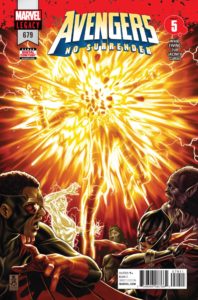 only be right to let him close the curtains and the lights on the way out…). She-Hulk, on the penultimate issue of its current run, finally gets Jen back to normal: a welcome development, and one that’s presented well, but comes about a year too late to save it; this book, despite its charms, just moved too slowly, and darkly, to find an audience. Runaways, on the other hand, ends its initial comeback story in fine fashion, with a couple of pitch-perfect emotional beats that should keep older fans happy, and give its skillful creative
only be right to let him close the curtains and the lights on the way out…). She-Hulk, on the penultimate issue of its current run, finally gets Jen back to normal: a welcome development, and one that’s presented well, but comes about a year too late to save it; this book, despite its charms, just moved too slowly, and darkly, to find an audience. Runaways, on the other hand, ends its initial comeback story in fine fashion, with a couple of pitch-perfect emotional beats that should keep older fans happy, and give its skillful creative  team the space to tell a few more trades’ worth of tales. Avengers continues its weekly “No Surrender” adventure, which has evolved into the Gamesmaster and a rival Elder turning the captured Earth into a gameboard for their rival teams of super-villains to ravage; I continue to like the chapter-a-week headlong rush of the character- and action-stuffed story. Black Bolt runs parallel to the recently-released Inhumans: Judgment Day, giving its title character’s perspective on an astral-plane encounter
team the space to tell a few more trades’ worth of tales. Avengers continues its weekly “No Surrender” adventure, which has evolved into the Gamesmaster and a rival Elder turning the captured Earth into a gameboard for their rival teams of super-villains to ravage; I continue to like the chapter-a-week headlong rush of the character- and action-stuffed story. Black Bolt runs parallel to the recently-released Inhumans: Judgment Day, giving its title character’s perspective on an astral-plane encounter  with Medusa in the latter title; Saladin Ahmed offers a slightly-lower-rent version of the rich characterization and offbeat storytelling of rising stars like Tom King or Donny Cates, and he’s helped considerably by Christian Ward’s color-drenched dreamscapes. Hawkeye‘s art is the opposite: precise figure work and panel grids that break form just often enough to keep readers on their toes, in service to a smart, wisecracking tone that’s doubled with the presence of guest star and Other Hawkeye Clint Barton; this book’s leaving soon, too, and even in weeks with 25 or 30 other titles, like this one, I’ll miss it.
with Medusa in the latter title; Saladin Ahmed offers a slightly-lower-rent version of the rich characterization and offbeat storytelling of rising stars like Tom King or Donny Cates, and he’s helped considerably by Christian Ward’s color-drenched dreamscapes. Hawkeye‘s art is the opposite: precise figure work and panel grids that break form just often enough to keep readers on their toes, in service to a smart, wisecracking tone that’s doubled with the presence of guest star and Other Hawkeye Clint Barton; this book’s leaving soon, too, and even in weeks with 25 or 30 other titles, like this one, I’ll miss it.
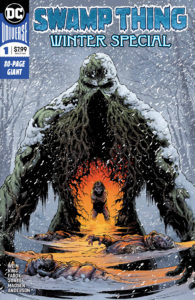 Swamp Thing Winter Special #1 (of 1) — (First Story): Writer: Tom King; Art: Jason Fabok; Colors: Brad Anderson; (Second Story): Writer: Len Wein; Art: Kelley Jones; Colors: Michelle Madsen
Swamp Thing Winter Special #1 (of 1) — (First Story): Writer: Tom King; Art: Jason Fabok; Colors: Brad Anderson; (Second Story): Writer: Len Wein; Art: Kelley Jones; Colors: Michelle Madsen
Young Monsters in Love #1 (of 1) — Creators: various
Milk Wars: Mother Panic and Batman #1 (of 1) — Writer: Jody Houser; Art: Ty Templeton; Colors: Keiren Smith
Black Lightning: Cold Dead Hands #4 (of 6) — Writer: Tony Isabella; Art: Clayton Henry and Yvel Guiches;  Colors: Pete Pantazis
Colors: Pete Pantazis
Batman #40 — Writer: Tom King; Art: Joelle Jones; Colors: Jordie Bellaire
Batman: White Knight #5 (of 8) — Writer/Artist: Sean Murphy; Colors: Matt Hollingsworth
Harvey and Ivy Meet Betty and Veronica #5 (of 6) — Writers: Marc Andreyko and Paul Dini; Art: Laura Braga and Adriana Melo; Colors: Arif Prianto with Tony Avina
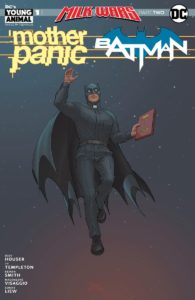 It’s weird to have a character like Swamp Thing, currently without his own title, cover-featured on two square-bound giant comics in one week, but here we are: Swamp Thing Winter Special justifies its $7.99 price with, first, a 38-page story by red-hot writer Tom King and some beautiful art by Jason Fabok; besides that, there’s a new 20-page story by the late Len Wein, the character’s creator; Kelley Jones, whose EC-inspired style has been working wonders with both superhero and horror tales for decades, drew it based on his plot, but Wein died before he could script it — so DC offers the wordless pages, plus Wein’s
It’s weird to have a character like Swamp Thing, currently without his own title, cover-featured on two square-bound giant comics in one week, but here we are: Swamp Thing Winter Special justifies its $7.99 price with, first, a 38-page story by red-hot writer Tom King and some beautiful art by Jason Fabok; besides that, there’s a new 20-page story by the late Len Wein, the character’s creator; Kelley Jones, whose EC-inspired style has been working wonders with both superhero and horror tales for decades, drew it based on his plot, but Wein died before he could script it — so DC offers the wordless pages, plus Wein’s 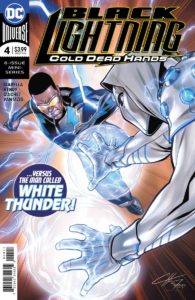 original outline/plot/script, plus a couple of tribute pages to Wein himself. That’s a classy move, and, combined with the King/Fabok story, makes this the best comic of the week. Young Monsters in Love is a Valentine’s Day/Hallowe’en mashup anthology with ten eight-page stories, and the credits tell the tale: the lead is a Man-Bat/Batman story by Kelley Jones (again), written by Kyle Higgins. There’s also: a Frankenstein story by Tim Seeley, Giuseppe Camuncoli and Cam Smith; a Solomon Grundy/Superman one by Mairghread Scott, Bryan Hitch and Andrew Currie; Raven by Collin Kelly, Jackson Lanzing and Javier Fernendez; Deadman by Paul Dini and Guillem
original outline/plot/script, plus a couple of tribute pages to Wein himself. That’s a classy move, and, combined with the King/Fabok story, makes this the best comic of the week. Young Monsters in Love is a Valentine’s Day/Hallowe’en mashup anthology with ten eight-page stories, and the credits tell the tale: the lead is a Man-Bat/Batman story by Kelley Jones (again), written by Kyle Higgins. There’s also: a Frankenstein story by Tim Seeley, Giuseppe Camuncoli and Cam Smith; a Solomon Grundy/Superman one by Mairghread Scott, Bryan Hitch and Andrew Currie; Raven by Collin Kelly, Jackson Lanzing and Javier Fernendez; Deadman by Paul Dini and Guillem 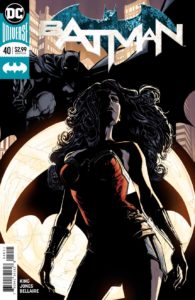 March; Swamp Thing by Mark Russell and Frazer Irving; Monsieur Mallah and the Brain (the old Doom Patrol adversaries who are also lovers) by Steve Orlando and Nic Klein; I, Vampire by Alisa Kwitney and Stephanie Hans; the Demon by Phil Hester and Mirko Colak; and Creature Commandos by James Robinson and JHohn McCrea. That truly is an all-star creative lineup, and more than justifies the book’s $9.99 price tag. Meanwhile, the next installment of the “Milk Wars” crossover between the Young Animal imprint characters and the Justice League (wherein the JL has been brainwashed into ’50s-style conformity dream worlds) continues with a Mother Panic/Batman team-up; it does its job by telling its one-
March; Swamp Thing by Mark Russell and Frazer Irving; Monsieur Mallah and the Brain (the old Doom Patrol adversaries who are also lovers) by Steve Orlando and Nic Klein; I, Vampire by Alisa Kwitney and Stephanie Hans; the Demon by Phil Hester and Mirko Colak; and Creature Commandos by James Robinson and JHohn McCrea. That truly is an all-star creative lineup, and more than justifies the book’s $9.99 price tag. Meanwhile, the next installment of the “Milk Wars” crossover between the Young Animal imprint characters and the Justice League (wherein the JL has been brainwashed into ’50s-style conformity dream worlds) continues with a Mother Panic/Batman team-up; it does its job by telling its one-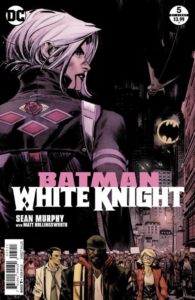 issue tale while incrementally advancing the crossover plot, and in making Batman fans curious enough about the Mother Panic character (also a Gotham-based vigilante) to check out her book. Black Lightning, impelled by what increasingly looks like a hit TV show, continues its new mini-series, authored by the character’s creator, Tony Isabella; he’s been writing comics since the ’70s, but this is a modern, socially-aware tale that gives equal weight to all the sides in the urban-violence debate, while crafting characters we care about and giving them suitably heroic (or villainous) things to do; it’s visually attractive, too — BL’s electrical powers lend themselves to cool pictures, and both the artists and the
issue tale while incrementally advancing the crossover plot, and in making Batman fans curious enough about the Mother Panic character (also a Gotham-based vigilante) to check out her book. Black Lightning, impelled by what increasingly looks like a hit TV show, continues its new mini-series, authored by the character’s creator, Tony Isabella; he’s been writing comics since the ’70s, but this is a modern, socially-aware tale that gives equal weight to all the sides in the urban-violence debate, while crafting characters we care about and giving them suitably heroic (or villainous) things to do; it’s visually attractive, too — BL’s electrical powers lend themselves to cool pictures, and both the artists and the  colorist use that to advantage. Batman concludes a two-parter with Bruce and Wonder Woman trapped for decades (but not aging) in a barbarian constant-warfare dimension: the Joelle Jones art and the Tom King characterization (especially the conversations on the last two pages) carry it, Batman: White Knight continues to be the Elseworlds-style Joker/Harley Quinn/Harley Quinn story we didn’t know we needed (until Sean Murphy created it), and the exact same can be said for Harley and Ivy Meet Betty and Veronica: who knew that quartet (and their respective Gotham/Riverdale settings) could combine so entertainingly, or end up in such a literally-explosive climax?
colorist use that to advantage. Batman concludes a two-parter with Bruce and Wonder Woman trapped for decades (but not aging) in a barbarian constant-warfare dimension: the Joelle Jones art and the Tom King characterization (especially the conversations on the last two pages) carry it, Batman: White Knight continues to be the Elseworlds-style Joker/Harley Quinn/Harley Quinn story we didn’t know we needed (until Sean Murphy created it), and the exact same can be said for Harley and Ivy Meet Betty and Veronica: who knew that quartet (and their respective Gotham/Riverdale settings) could combine so entertainingly, or end up in such a literally-explosive climax?
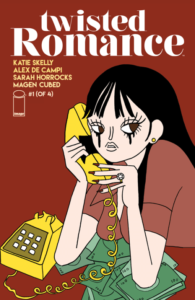 Twisted Romance #1 (of 4) — Writer: Alex de Campi; Art/Colors: Katie Skelly
Twisted Romance #1 (of 4) — Writer: Alex de Campi; Art/Colors: Katie Skelly
Incognegro: Renaissance #1 (of 5) — Writer: Mat Johnson; Art: Warren Pleece
VS #1 — Writer: Ivan Brandon; Art: Esad Ribic
Twisted Romance is an indy Valentine’s Day-timed anthology mini-series, anchored by a 28-page story illustrated by the mighty Katie Skelly, who’s teamed with 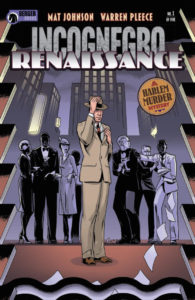 Alex de Campi to tell a tale about a company that, for a fee, gets rid of romantic rivals; it’s a very modern horror story about some very old monsters, and Skelly’s open, bright, deceptively-primitive style handles the club scenes, the fashions, and the horror with confidence and pizzazz. There’s also an eight-page Sarah Horrocks story, and a text-only one from Magen Cubed, but it’s the lead that you’ll remember — and fondly. Incognegro is the second mini-series about Zane Pinchback, a journalist in 1920s New York who’s black but can pass for white (hence the title), and so moves between both worlds; it’s also a murder mystery set during the
Alex de Campi to tell a tale about a company that, for a fee, gets rid of romantic rivals; it’s a very modern horror story about some very old monsters, and Skelly’s open, bright, deceptively-primitive style handles the club scenes, the fashions, and the horror with confidence and pizzazz. There’s also an eight-page Sarah Horrocks story, and a text-only one from Magen Cubed, but it’s the lead that you’ll remember — and fondly. Incognegro is the second mini-series about Zane Pinchback, a journalist in 1920s New York who’s black but can pass for white (hence the title), and so moves between both worlds; it’s also a murder mystery set during the 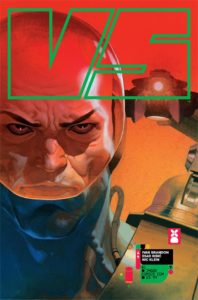 Harlem Renaissance, mingling fictional and historical folk, and it’s well-researched, character-rich, good-looking (thanks to the Warren Pleece art) and has heartfelt themes that speaks both to its time and ours. VS is about teams equipped with high-tech weaponry who try to kill one another while they’re being filmed as media entertainment; if you mashed up the Super Bowl, The Hunger Games and Call of Duty, you’d be close — but what distinguishes it is the art by Esad Ribic, who’s good at the tech, the blood and the fighting in equal measure, and gets off a few cool Frazetta-esque panels; if you liked his Thor volumes with Jason Aaron, you’ll like this too.
Harlem Renaissance, mingling fictional and historical folk, and it’s well-researched, character-rich, good-looking (thanks to the Warren Pleece art) and has heartfelt themes that speaks both to its time and ours. VS is about teams equipped with high-tech weaponry who try to kill one another while they’re being filmed as media entertainment; if you mashed up the Super Bowl, The Hunger Games and Call of Duty, you’d be close — but what distinguishes it is the art by Esad Ribic, who’s good at the tech, the blood and the fighting in equal measure, and gets off a few cool Frazetta-esque panels; if you liked his Thor volumes with Jason Aaron, you’ll like this too.
 Rock Candy Mountain #8 (of 8) — Writer/Artist: Kyle Starks; Colors: Chris Schweizer
Rock Candy Mountain #8 (of 8) — Writer/Artist: Kyle Starks; Colors: Chris Schweizer
Snotgirl #9 — Writer: Bryan Lee O’Malley; Art: Leslie Hung; Colors: Rachael Cohen
Koshchei the Deathless #2 (of 6) — Writer: Mike Mignola; Art: Ben Stenbeck; Colors: Dave Stewart
 Paper Girls #20 — Writer: Brian K. Vaughan; Art: Cliff Chiang; Colors: Matt Wilson
Paper Girls #20 — Writer: Brian K. Vaughan; Art: Cliff Chiang; Colors: Matt Wilson
I Hate Fairyland #16 — Writer/Artist: Skottie Young; Colors: Jean-Francois Beaulieu
The Wicked and the Divine: 1923AD #1 (of 1) — Writer:  Kieron Gillen; Art/Colors: Aud Koch
Kieron Gillen; Art/Colors: Aud Koch
Rock Candy Mountain ends in high fashion, with a fight with the devil (three of them), a glory train and tears — of joy or sadness, I’ll leave to the reader to discover. Kyle Starks is another of those artists with a simple-looking style who manages to pull off complex physical actions and emotions and make them all crystal-clear, and this early-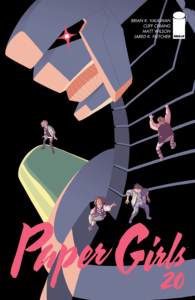 20th-century tale combining hobo lore and American tall tales shows off his abilities wonderfully; it’s going to make a killer, perpetually-selling graphic novel. Snotgirl comes out so sporadically that I keep piling them up, hoping to read it all in one sitting so that I can remember what’s going on and it actually makes sense, but Bryan Lee O’Malley’s social satire and Leslie Hung’s manga-style beautiful people and fashions make it all work anyway. Koshchei the Deathless is a Mike Mignola-written
20th-century tale combining hobo lore and American tall tales shows off his abilities wonderfully; it’s going to make a killer, perpetually-selling graphic novel. Snotgirl comes out so sporadically that I keep piling them up, hoping to read it all in one sitting so that I can remember what’s going on and it actually makes sense, but Bryan Lee O’Malley’s social satire and Leslie Hung’s manga-style beautiful people and fashions make it all work anyway. Koshchei the Deathless is a Mike Mignola-written 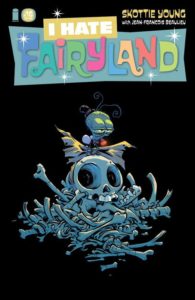 story about a Hellboy villain, with Hellboy actually in it, and his dark, fairy-tale characters and horror elements are handled expertly by Ben Stenbeck. Paper Girls continues to see Brian K. Vaughan working out time-travel paradoxes and criss-crossings, with the young suburban entrepreneurs of the title getting all the Spielbergian-style adventure they could hope for, while a new I Hate Fairyland is always welcome, if only to see how Skottie Young keeps ringing new
story about a Hellboy villain, with Hellboy actually in it, and his dark, fairy-tale characters and horror elements are handled expertly by Ben Stenbeck. Paper Girls continues to see Brian K. Vaughan working out time-travel paradoxes and criss-crossings, with the young suburban entrepreneurs of the title getting all the Spielbergian-style adventure they could hope for, while a new I Hate Fairyland is always welcome, if only to see how Skottie Young keeps ringing new 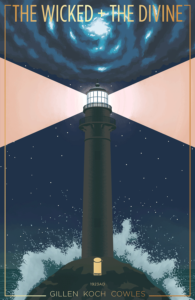 changes on his heroine’s quest to (a) get back home, and (b) destroy every last stinking denizen of the title setting. If that sounds like fun… well, it is, even if you (and I) are terrible people for thinking so. Finally, The Wicked and the Divine offers one of its periodic stand-alone “times past” issues, this one set during the Jazz Age; it’s part-text and part-art, with the god avatars experiencing a very Agatha Christie And Then There Were None culling. If you haven’t been following the regular title, it will make little sense, but if you have it’s a fun diversion, and dispenses a couple of hints about the plot in the main title, too.
changes on his heroine’s quest to (a) get back home, and (b) destroy every last stinking denizen of the title setting. If that sounds like fun… well, it is, even if you (and I) are terrible people for thinking so. Finally, The Wicked and the Divine offers one of its periodic stand-alone “times past” issues, this one set during the Jazz Age; it’s part-text and part-art, with the god avatars experiencing a very Agatha Christie And Then There Were None culling. If you haven’t been following the regular title, it will make little sense, but if you have it’s a fun diversion, and dispenses a couple of hints about the plot in the main title, too.



